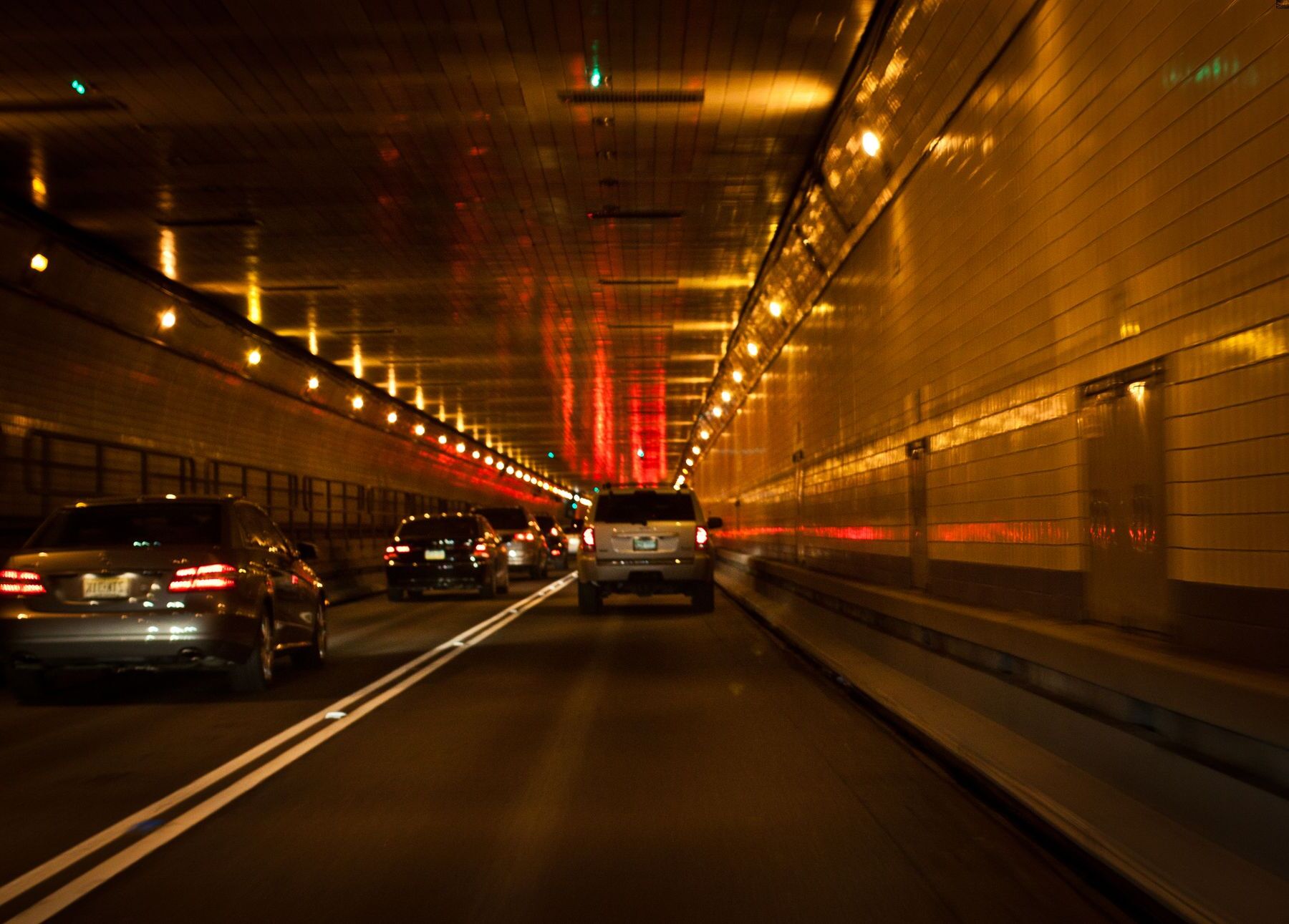
Have you ever wondered how millions of vehicles travel between New Jersey and New York City every day? The Lincoln Tunnel, a marvel of engineering, makes this possible. Stretching 1.5 miles under the Hudson River, it connects Weehawken, New Jersey, to Midtown Manhattan. Designed by Ole Singstad, this tunnel opened in stages from 1937 to 1957. With three tubes and six lanes, it handles around 120,000 vehicles daily. The tunnel even has a dedicated bus lane, the XBL, serving 62,000 commuters each morning. From its original name, "Midtown Hudson Tunnel," to its role in shaping regional traffic, the Lincoln Tunnel remains a vital artery for millions.
Key Takeaways:
- The Lincoln Tunnel is a vital link between New Jersey and New York City, handling the busiest vehicular traffic globally and showcasing remarkable engineering and historical significance.
- With its three tubes, the Lincoln Tunnel manages massive traffic flow efficiently, reduces reliance on railroads and ferries, and remains a critical transportation artery, reflecting early 20th-century engineering prowess and financial resilience.
The Lincoln Tunnel: A Marvel of Engineering
The Lincoln Tunnel is a vital connection between New Jersey and New York City. This tunnel, stretching under the Hudson River, is not just a feat of engineering but a lifeline for millions of commuters.
-
Location and Length: The Lincoln Tunnel spans approximately 1.5 miles (2.4 kilometers), linking Weehawken, New Jersey, to Midtown Manhattan in New York City.
-
Design and Construction: Designed by Ole Singstad, the tunnel was built in stages from 1934 to 1957. The central tube opened first in 1937, followed by the northern tube in 1945, and the southern tube in 1957.
-
Original Name: Initially proposed as the "Midtown Hudson Tunnel," it was renamed after Abraham Lincoln in 1937.
-
Traffic Capacity: The tunnel has six traffic lanes. The center tube features reversible lanes, while the northern and southern tubes handle westbound and eastbound traffic, respectively.
-
Annual Traffic: With around 21 million vehicles passing through annually, it is the busiest vehicular tunnel globally.
Daily Operations and Unique Features
The Lincoln Tunnel isn't just about connecting two points; it's about managing a massive flow of traffic efficiently and safely.
-
Daily Traffic: On average, 120,000 vehicles use the tunnel daily, with peak times during morning rush hours.
-
Bus Lane: A dedicated bus lane, the XBL, operates weekday mornings, accommodating about 1,700 buses and 62,000 commuters daily.
-
History of Construction: At its peak, the construction project employed 2,800 workers who collectively worked over 6.3 million hours.
-
Financial Challenges: The Great Depression posed financial hurdles, but with significant support, the central tube was completed in 1937.
-
Tolling System: Tolls are collected only for New York-bound traffic, currently set at $6.00 for E-ZPass users.
Engineering and Structural Highlights
The Lincoln Tunnel's construction and design are testaments to human ingenuity and perseverance.
-
Approach Roadways: The New Jersey approach, known as "the Helix" or "the Corkscrew," spirals before reaching the toll booths.
-
Ventilation System: A sophisticated ventilation system ensures constant air circulation, maintaining air quality inside the tunnel.
-
First Car Through the Tunnel: Omero C. Catan, a Manhattan salesman, drove the first car through after waiting 30 hours in line.
-
Third Tube Construction: Proposed in 1950 due to high demand, the third tube opened in May 1957 after resolving disputes over approaches.
-
Traffic Impact: The tunnel reduced dependency on commuter railroads and ferries, encouraging car and bus travel.
Historical Significance and Unique Events
The Lincoln Tunnel has seen its share of unique events and holds historical significance in the region.
-
Engineering Feat: Running 97 feet below the Hudson River, its construction was a remarkable engineering challenge.
-
Crimes in the Tunnel: Notable incidents include a 1953 attempted robbery, leading to improved security measures over time.
-
Unique Events: In 1971, 19 elephants, a zebra, a llama, and a pony walked through the tunnel to Manhattan.
-
Surrounding Landmarks: The Midtown Manhattan entrance is near landmarks like the Intrepid Sea, Air, and Space Museum and the High Line park.
-
Tourist Attraction: The area around the Midtown entrance is popular with tourists, offering views of the Hudson River and New Jersey.
Traffic Management and Regional Impact
Managing traffic flow and its impact on the region has been a continuous effort since the tunnel's inception.
-
Traffic Flow: During morning rush hours, one lane in the center tube is exclusively for buses, making it the busiest bus lane in the U.S.
-
Historical Significance: Supported by Mayor Fiorello LaGuardia and Robert Moses, the tunnel played a crucial role in the mid-20th-century expansion of the New York metropolitan area.
-
Employment During Construction: The project provided significant employment during the Great Depression, with workers contributing millions of hours.
-
Material Shortages: World War II caused delays in the northern tube's construction, pushing its opening to 1945.
-
Approach Disputes: Disputes over tunnel approaches delayed the third tube's construction, which eventually opened in 1957.
Financial and Engineering Innovations
The Lincoln Tunnel's construction involved significant financial investment and innovative engineering solutions.
-
Financial Costs: The central tube cost approximately $80 million, while all three tubes combined cost around $1.5 billion.
-
Traffic Management Improvements: Over the years, traffic management has improved with changes to security and tolling methods.
-
Regional Impact: By facilitating more car and bus traffic, the tunnel reduced reliance on railroads and ferries, boosting regional growth.
-
Engineering Innovations: Features like reversible lanes in the center tube and exclusive traffic lanes in the northern and southern tubes showcase engineering creativity.
-
Legacy and Importance: The Lincoln Tunnel remains a critical transportation artery, reflecting early 20th-century engineering prowess and financial resilience.
Lincoln Tunnel's Lasting Impact
The Lincoln Tunnel stands as a marvel of engineering and a vital artery connecting New Jersey to Midtown Manhattan. Spanning 1.5 miles under the Hudson River, it handles around 120,000 vehicles daily, making it the busiest vehicular tunnel worldwide. Designed by Ole Singstad and completed in stages from 1937 to 1957, the tunnel overcame financial hurdles and material shortages, especially during World War II. Its dedicated bus lane, known as the XBL, is a game-changer for commuters, accommodating 62,000 people each morning. The tunnel's construction provided significant employment during the Great Depression, and its innovative design features, like reversible lanes, set it apart. From its role in regional development to unique events like elephants walking through, the Lincoln Tunnel remains a crucial part of the area's infrastructure and history. Its legacy continues to shape daily life and travel in the region.
Frequently Asked Questions
Was this page helpful?
Our commitment to delivering trustworthy and engaging content is at the heart of what we do. Each fact on our site is contributed by real users like you, bringing a wealth of diverse insights and information. To ensure the highest standards of accuracy and reliability, our dedicated editors meticulously review each submission. This process guarantees that the facts we share are not only fascinating but also credible. Trust in our commitment to quality and authenticity as you explore and learn with us.


